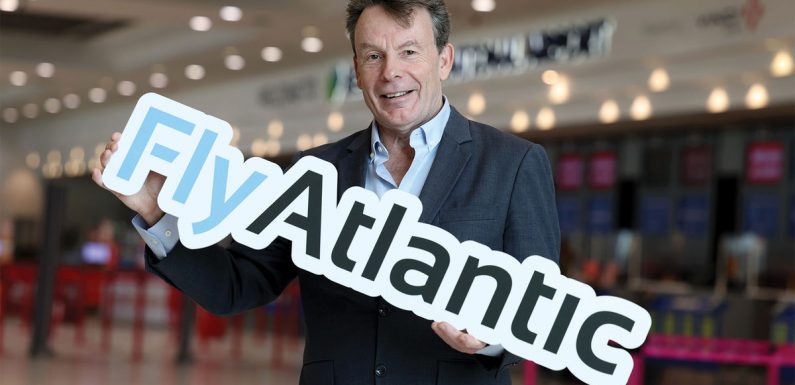
The head of a planned startup transatlantic carrier, Fly Atlantic, is looking to Spirit and Ireland-based Ryanair for inspiration.
“What I particularly admire is their vigorous pursuit of low costs and their devotion to the tenets of low cost,” said Andrew Pyne, the CEO of Fly Atlantic.
Late last month, Pyne and the Fly Atlantic team announced their startup plans from Belfast Airport, which they plan to make the carrier’s connecting hub for one-stop service between North America and points deeper into Europe as well as North Africa and the Middle East.
The nascent carrier is targeting a launch in summer 2024, most likely using Airbus A321LR single-aisle aircraft.
The planes, said Pyne, will be configured with two cabins. But in most other respects Fly Atlantic plans to operate as an ultralow-cost carrier, with a model that includes up-charges for many services in economy cabins, including food and seat selection.
The company is targeting a 35-city route map, split largely evenly between the North American and the European sides of the Atlantic, by 2028.
While Pyne said he draws inspiration from the Spirit and Ryanair models, Fly Atlantic’s operating plan most closely reflects those of Icelandair and the startup discount carrier Play. Both of those airlines operate one-stop networks between North America and Europe through a hub in Reykjavik, Iceland.
Pyne, though, contends that Belfast is better suited than Reykjavik to hub a connecting low-cost, transatlantic network due to the lower wage environment in Northern Ireland compared with Iceland in addition to the lower fees charged by Belfast Airport compared to Keflavik Airport, which serves Reykjavik.
Keeping costs down, he said, is the most crucial element in being able to offer flyers the primary thing they are looking for in a low-cost airline.
“You have to offer low fares. And to offer low fares, you have to have a low cost structure,” Pyne said.
The airline industry veteran is no stranger to launching long-haul, low-cost airlines. He previously helped lead Macau-based Viva Macau, Russia-based Avianova and Cyprus-based Cobalt Air to launch. All three carriers, though, have since failed for various reasons.
In 2017, Pyne also served for nine months as a strategic advisor at Wow, the Icelandic discount carrier that failed in 2019.
Skeptics weigh in
Some analysts see rough sailing ahead for Fly Atlantic. The long-haul, low-cost airline model has thus far not proven to be sustainable over the long term, with the collapse of Wow and the pandemic-era failure of Norwegian Air’s long-haul network being just two examples.
Using Belfast as hub could be a particular challenge for Fly Atlantic, said airline industry analyst Bob Mann of R.W. Mann & Co.
“The usual formula for success as a hub-and-spoke operator is greater than one-third of traffic and revenue sourced from the hub city population and a diverse and booming local business and economy, with the balance flowing through,” Mann said.
He noted that Belfast struggles with more unemployment and weaker wages compared with Dublin, and it also has a relatively small population.
“I can’t see it as a successful prospect,” Mann said.
Brett Snyder, a travel advisor who is author of the Cranky Flier blog, argued that unlike Iceland, Northern Ireland isn’t a strong tourism market. As a result, Fly Atlantic wouldn’t be able to readily draw customers by offering free, multiday stopovers in Belfast, as Icelandair has successfully done in Reykjavik.
Furthermore, the carrier will face competition on its European legs from discount carriers already operating at Belfast Airport, most notably EasyJet.
Snyder also pointed to range limitations on the A321LR that will prevent Fly Atlantic from reaching beyond the Northeast, Midwest and the mid-Atlantic in the U.S.
Pyne, however, is bullish on Belfast.
In addition to offering a low-cost environment, he said, the city can also draw flyers headed into and out of Northern Ireland, where the population is nearly six times that of Iceland.
Source: Read Full Article









